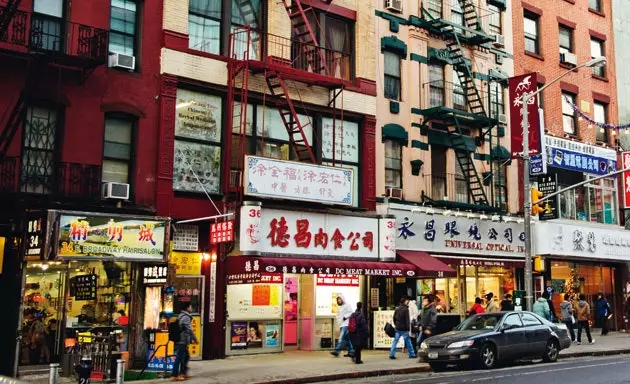
Chinatown in all its glory
Walking through Chinatown sometimes it takes several minutes to walk a couple of meters because tourists mill around the stalls . They pick out the batch of 'I Love new york' t-shirts that they're going to wear to everyone they know, or haggle for a knockoff Rolex. Meanwhile, a group of slanted-eyed men unload from their unidentified gender wheelbarrows that passes from hand to hand through very long corridors that one never knows where they may end.
In addition to seeing the Buddhist temple Eastern States Buddhist Temple , the Georgian Church of the Transfiguration and the Chinese in America Museum , which opened its new headquarters (215 Center St.) in 2009, there really isn't much else to do in Chinatown. Here you come to enjoy the chaos, try some of the delicacies from their stalls and browse through the crowds. Entertainment is guaranteed in this crowded neighborhood , especially if you are fond of everyday scenes: old people playing xiang qi or in the temple and, above all, many people shopping.
Many of the signs are written with Chinese ideograms, others in English, but when you try to ask the employees of the chaotic food, perfume or miscellaneous stores, communication becomes so uphill as if we were lost in Beijing itself.
If this happens now, it is possible to imagine how the understanding between one and the other must have turned out in the origins of the neighborhood, when the first immigrants arrived in the mid-nineteenth century and, above all, from 1965, the year in which the great wave took place , thanks to much more permissive immigration laws by the US government. On the other side of the country, on the California coast, the Chinese already had almost a century of advantage: they arrived around 1852, attracted by the gold rush, and then they stayed to work as laborers in the construction of the railway that would link the two costs. Many of them traveled to New York. There was a new world of possibilities open to them.
Their natural tendency, wherever they were, was always to settle in ghettos, that is, in what would be called the Chinatowns that still exist in some cities in the United States and that, in general, did not enjoy a very good reputation. For a while, in fact, this area was considered one of the most dangerous areas of the city . Although the area is now completely safe, it is not surprising that almost no New Yorker missed anything here (except for a few smart ones who were already beginning to make tourist visits to the exotic and unusual of this neighborhood in the heart of New York.
The initial area of Chinatown (the Mott, Pell and Doyers streets ) was expanding and now not only welcomes half of the Chinese population of the entire city but it has also been joined by immigrants from other parts of South Asia. Currently, after the Dominican colony, the Chinese community is the most populous in New York.
Map: See map
Guy: Neighborhoods
